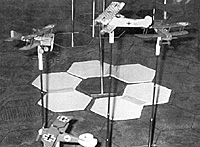World War I in the air has always interested me. 83 years ago, when that war started, aviation - of any sort - was cutting-edge technology. Powered (winged) flight was only 11 years old at war's start. Technology was rushing forward at breakneck speed, even as the combatants tried to figure out how to use it. Aerial maneuvers still used today were invented in WW I. The aircraft seemed more graceful, their colors, more pleasant, and the air war in general, more individual, than anything that followed in later wars. All of this draws one to wanting to play it out on the tabletop...
Beyond the spectacle of several brightly colored biplanes swirling around one another (on the tabletop) - anybody who's seen a WW I aerial miniatures game at a convention will know what I mean - WW I air gaming is among the least expensive areas to game in as "a change of pace" or "Oh no - not another gaming period!". This article will attempt three things. It will survey the various WW I aircraft miniatures ranges of which I'm aware. It will (relatively) briefly introduce the reader to WW I aircraft colors and markings. Lastly, it will survey many of the various sets of WW I air combat rules currently available (as well as several sets that aren't).
The main combatants - Germany and Austria-Hungary on one side, and everybody else except the Turks (they later sided with the Germans) on the other - started WW I with a motley collection of unarmed biplanes and monoplanes, most of whom had seen prewar civilian service. Air power's primary role was seen as one of observation and recon, with bombing as a secondary role. As the sides got organized it became apparent that the best way to keep the enemy from observing, photographing, and dropping things on one's own troops was to deny them access to one's airspace.
Quite quickly, aircraft armament progressed from the ad-hoc (carbines, pistols, etc.) to the scientific, as first one (France: Roland Garos), then the others came up with various ways of mounting machine guns (MGs) on their aircraft so as to be able to shoot at enemy aircraft observing, photographing, and bombing their troops. All of this resulted in the evolution of three basic aircraft types.
The first was the multi-engine heavy bomber, such as the big Handley Pages, the Gothas, and the AEGs. The type will not have its colors examined in much depth by this article because: a. their activities fell outside what seems to me to be the mainstream of WW I air combat gaming; b. their colors were quite involved (in the case of the Germans) - essentially everything that will follow regarding scouts and two-seaters, could be repeated for the heavy bombers, but with different colors and shapes; and c. much less is known with certainty about their colors. Some notes on the German Gotha series will appear, however, because they served for a time as day bombers and (mainly) because several manufacturers make miniatures of it.
The second type was the single-engine two-seater. This jack of all trades bombed enemy troops, spotted for artillery fire against them, and took their pictures. This was the working-class aircraft of the various air services and included such aircraft as the British DeHavilland light bombers and RE (recon experimental) types, the French Nieuport, Salmson, and Breguet two-seaters, and the various German C-class and CL-class two-seaters.
The final aircraft type was, or course, the single-seat scout, pursuit, or fighter aircraft. These were the aircraft whose job it was to shoot down enemy two-seaters, prevent enemy scouts from shooting down their own two-seaters, and generally denying the enemy the air. These were the glamour aircraft and their markings showed it. Examples included the British Sopwiths, the French Nieuport and SPAD single-seaters, and any of the German E (monoplane), D (biplane), or Dr (triplane) classes of scouts.
What do you need to get started in this fascinating area of miniatures gaming? Very little: a set of game rules to govern your combats; a tabletop (preferably covered in a light blue cloth) on which to play; and most importantly, a two-seater or two and a handful of scouts for each side to take to the air! This will keep several players busy for quite some time.
More WWI Air
 You've decided to take the plunge and get into WW I air gaming with miniatures. Perhaps you played one or more of the boardgames examined elsewhere in this article, maybe you're a plastic modeler who wants to do something with your models, or possibly you've been invited/coerced into a demo game at a game convention. Whatever your reason, you've decided to become involved in what, to me, is one of the most interesting and entertaining areas of miniatures gaming!
You've decided to take the plunge and get into WW I air gaming with miniatures. Perhaps you played one or more of the boardgames examined elsewhere in this article, maybe you're a plastic modeler who wants to do something with your models, or possibly you've been invited/coerced into a demo game at a game convention. Whatever your reason, you've decided to become involved in what, to me, is one of the most interesting and entertaining areas of miniatures gaming!
Background
Getting Started
Introduction to WWI Air Gaming
Survey of WWI Aircraft Gaming Miniatures
Survey of WWI Air Combat Rules
Bibliography
Air Rules Chart
Back to Table of Contents -- Courier #74
To Courier List of Issues
To MagWeb Master Magazine List
© Copyright 1998 by The Courier Publishing Company.
This article appears in MagWeb (Magazine Web) on the Internet World Wide Web.
Other military history articles and gaming articles are available at http://www.magweb.com